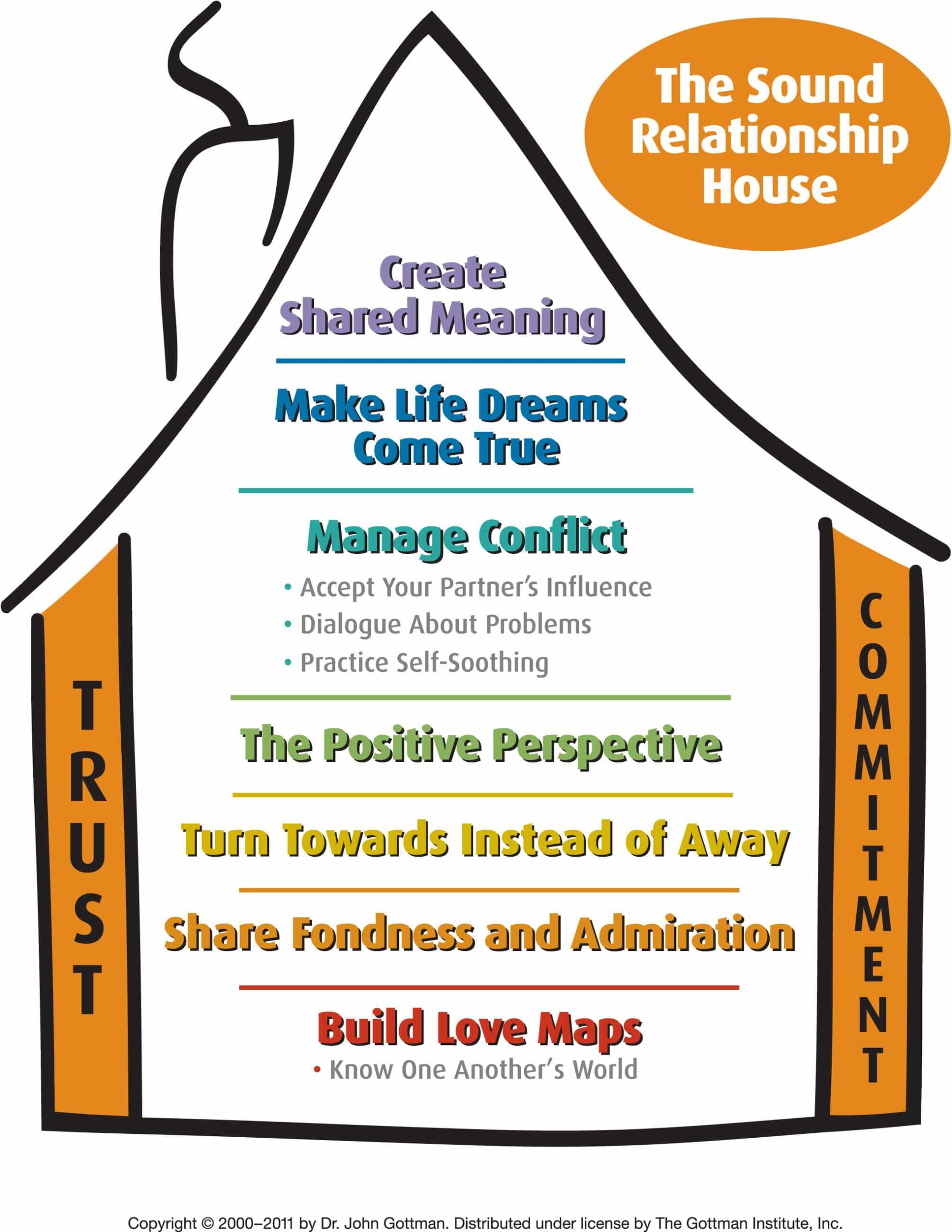What makes a relationship last? To know the difference between folklore and science is necessary for a science-based couples therapist. According to Drs. John and Julie Gottman, who have studied couples for over 40 years, the key lies in the Sound Relationship House (SRH) Theory. This research-based framework outlines seven levels that form the structure of a healthy, enduring relationship. By understanding and implementing these principles, couples can strengthen their connection and navigate challenges more effectively. In this article, we’ll explore the SRH theory, how it’s used in Gottman Method Couples Therapy, and practical ways to apply it to your own relationship.
What Is the Sound Relationship House Theory?
The Sound Relationship House Theory, developed by Drs. John and Julie Gottman, is based on decades of research on what makes relationships succeed or fail. The theory posits that a healthy relationship is built on seven levels, each serving as a crucial component of the overall relationship structure. These levels are:
Build Love Maps:
Understanding your mate’s inner world, their hopes, dreams, fears, and preferences.
A love map is like a mental road map that a partner creates of their partner’s inner psychological world. It helps both spouses feel known in the relationship. When couples ask each other questions like, “What are your current worries and stresses?” or “What are some of your hopes, dreams, values, and goals in life?” they build love maps of each other’s worlds. By asking open-ended questions and remembering the answers, partners gain a deeper understanding of who their partner truly is.
When significant others ask each other a question, it’s like an invitation to come closer, be seen, and feel understood. This process of building love maps strengthens friendship.
Share Fondness and Admiration:
Expressing appreciation, respect, and affection for your mate regularly.
Nurturing affection, respect, and admiration in a relationship involves two steps:
- Developing a Positive Habit of Mind: Focus on qualities to admire, appreciate, and be proud of in your partner, instead of scanning for mistakes.
- Expressing Appreciation: Convey words of appreciation or admiration verbally or nonverbally, rather than keeping them hidden. Catch your partner doing something right and say, “Thanks for doing that.”
Turn Towards Instead of Away:
Responding positively to your intimate other’s bids for connection, even in small moments.
Partners often make verbal or nonverbal bids for emotional connection, seeking attention, humor, affection, support, and more. Responding positively to these bids, even in small ways, strengthens the relationship and acts like a deposit in the couple’s emotional bank account.
- Turning Toward: Making a positive response, like acknowledging the bid with “Huh!” or engaging enthusiastically by saying, “Wow, that is a beautiful boat. Let’s quit our jobs and sail away together!”
- Turning Away: Ignoring the bid completely.
- Turning Against: Responding negatively, like saying, “Will you be quiet? I’m trying to read!”
Love maps, fondness and admiration, and turning toward are the foundation of friendship and essential for humor and affection during conflict. They lead to smoother conflict management and effective repair attempts. A good-quality friendship is linked to deeper romance, passion, and good sex.
The Positive Perspective:
Maintaining a positive view of your partner and the relationship, even during conflicts.
When the friendship isn’t working, partners may enter negative sentiment override, interpreting neutral or positive actions as criticism or feeling like their companion doesn’t like them. Conversely, positive sentiment override means positive feelings about the relationship and partners’ “override” (ignore, minimize, reframe) negative behaviors. Negativity is seen not as criticism but as a sign of stress.
Manage Conflict:
Addressing disagreements and conflicts in a constructive, respectful manner.
Conflict management is crucial because relationship conflict is natural and can be positive, helping partners learn to love and understand each other better over time.
Masters of Relationships are couples who handle conflicts constructively and maintain a strong, positive connection. They demonstrate these behaviors by being:
- Gentle toward each other
- Use soften start-ups
- Accept influence from each other
- Self-soothe when becoming upset
- Actively repair and deescalate during conflict discussions
- Compromise
Research indicates that 69% of relationship conflicts are perpetual, stemming from personality or lifestyle differences. This is true of both happy and miserable couples. If an issue can’t be “resolved,” what is the alternative? It is the way in which the couples approach the conflict and how they communicate. Masters of relationship establish a calm dialogue, acknowledging the perpetual nature of the problem while accepting their partner with humor, respect, and affection.
Gridlocked Conflict vs. Dialogue:
- Gridlock: When there is gridlock, partners feel fundamentally rejected, polarized, and unable to compromise.
- Dialogue: In contrast, in dialogue, or productive conversations, they demonstrate positive affect (amusement, affection, empathy), and partners are effectively able to seek temporary compromises.
Gridlock often occurs due to deeply held values, needs, or dreams. They are like two fists pushing against one another. Rather than “resolving” perpetual problems, the goal is to be “curious and not furious” about these differences. Now the fists begin to open, and inside each finds values or principles (“dreams”) they hold dear.
By gaining greater insight into their loved one’s underlying dreams, partners can have a constructive dialogue that fosters understanding. More importantly, they begin to realize that if either of them “lose” at the expense of the other, both suffer. They can now work together to find new ways to support each other, even if the goals are parallel or sequential.
Make Life Dreams Come True:
Supporting each other’s aspirations and helping to make them a reality brings a richness to life, as each watches the other blossom.
Creating an environment that encourages partners to talk about their dreams, values, and aspirations honestly is crucial. It’s also often missing when the friendship system (the bottom three levels) aren’t working well. One partner’s dreams should be known and supported by the other, strengthening love maps at a deeper level. Effective conflict has allowed each of them to know each other more deeply, deepening the earlier “love maps” at the bottom of the relationship house.
Create Shared Meaning:
The task of shared meaning is to build a sense of purpose and meaning together through rituals, roles, and goals. What does a “family” or “home” mean to you? How important is sexuality in a couple’s life?
By strengthening each level, couples create a solid foundation that can withstand the tests of time and the inevitable challenges that arise.
A relationship is about building a life together that has a shared purpose and greater meaning. Victor Frankl suggested that happiness is found along the way while pursuing deeper meaning in life.
Couples create shared meaning by developing rituals of connection, supporting each other’s roles, defining shared goals, and agreeing on central values like “What is home?” “What are we here on Earth for?”
These rituals form “the attic” of the Sound Relationship House, looping back to the first level, building love maps but at more profound level.
This research using science and observation enable us to “plagiarize” knowledge about how to make love work directly from the masters and from the Disasters of relationship.
John & Julie Gottman
The Role of Sound Relationship House Questionnaires
Once the retrospective proof for what makes relationship succeed or fail was shown repeatedly, it was time to quantify this information. Could we ask questions ahead of time to learn how healthy a couple was at this point? The answer turned out to be ‘yes.’
To evaluate these key domains of marital functioning, Dr. Gottman developed a set of true/false self-report questionnaires known as the Sound Relationship House (SRH) questionnaires.1 These scales assess stability and communication patterns within relationships, focusing on:
- Friendship Quality: Measured by six scales—Love Maps, Fondness and Admiration, Turning Towards, Shared Goals, Shared Rituals, and Shared Symbols.
- Destructive Conflict: Evaluated through eight scales—Harsh Start-Up, Accepting Influence, Compromise, Four Horsemen of the Apocalypse, Gridlock on Perpetual Issues, Flooding, Negative Perspective Taking, and Repair Attempts.2
The SRH questionnaires help couples understand the specific challenges they face within their relationship. For instance, they may highlight issues with gridlock on perpetual issues or a lack of shared meaning, offering a starting point for couples and therapists to work together toward improvement.
How the SRH Is Used in Gottman Relationship Therapy
In Gottman Method Couples Therapy, the Sound Relationship House Theory serves as a roadmap for assessing and improving relationship health. Trained therapists use various tools to evaluate a couple’s strengths and growth areas in each of the seven levels.3
Based on this assessment, therapists tailor interventions to help couples build skills in specific areas. For example, if a couple struggles with turning towards each other, the therapist may teach them the “Stress-Reducing Conversation” exercise to practice active listening and empathy.4 If managing conflict is a challenge, the therapist might introduce the “Gottman-Rapoport Intervention” to help couples express their views without criticism or contempt.5
Applying the Sound Relationship House to Your Own Relationship
You don’t need to be in therapy to benefit from the Sound Relationship House Theory. Here are some practical tips for strengthening each level in your own relationship:
Build Love Maps:
- Set aside time for regular “Love Map” conversations, asking open-ended questions about your partner’s thoughts, feelings, and experiences.
- Show genuine interest in your partner’s answers and follow up with further questions.
Share Fondness and Admiration:
- Express appreciation for your partner’s qualities and actions, both big and small.
- Write a heartfelt letter of gratitude to your partner, detailing what you love and admire about them.
Turn Towards Instead of Away:
- Notice your partner’s bids for connection, such as a smile, a question, or a gentle touch.
- Respond positively to these bids, even if you’re busy or distracted.
The Positive Perspective:
- Look for the good in your partner and the relationship, even during difficult times.
- Express positive feelings and memories about your relationship regularly.
Manage Conflict:
- Use “I” statements and avoid the Four Horsemen: criticism, contempt, defensiveness, and stonewalling.
- Take breaks when needed and return to the discussion when you’re both calm.
Make Life Dreams Come True:
- Learn about your partner’s dreams and aspirations, and find ways to support them.
- Celebrate each other’s successes and milestones, no matter how small.
Create Shared Meaning:
- Develop rituals of connection, such as daily check-ins, weekly dates, or annual traditions.
- Work together to define your shared values, roles, and goals as a couple.
Remember, building a strong relationship is an ongoing process that requires consistent effort and attention. By focusing on these seven levels and making them a priority, you and your partner can create a more loving, resilient connection.
A Fresh Perspective on the Sound Relationship House
While the Sound Relationship House is often presented as a hierarchy, with each level building upon the one before, it can be helpful to think of it as an interconnected system. Each level influences and reinforces the others, creating a dynamic, cyclical process of relationship growth.
Moreover, the SRH principles can be adapted to various relationship contexts and cultures. The Gottmans’ research has studied couples from diverse backgrounds:
“Over the years, they studied couples from every major ethnic and racial group in America, as well as committed gay and lesbian couples. In addition, John Gottman spent 10 years with the late Neil Jacobson studying couples plagued by domestic violence. They also studied couples across the life span, including through being newlyweds, becoming parents, and through old age.”6
While the core concepts of emotional connection, positive interaction, and shared meaning are universal, how these principles manifest may vary based on a couple’s unique relationship and cultural background. By considering how these principles might apply to your own context, you can create a more personalized approach to strengthening your bond.
The Sound Relationship House can also serve as a tool for self-reflection and personal growth. By examining your own patterns and contributions to the relationship dynamic, you can identify areas for self-improvement and work on becoming a better partner. This individual growth can have a ripple effect, positively impacting not only your romantic relationship but also your friendships, family connections, and even work relationships.
Summary
The Gottman Sound Relationship House Theory provides a comprehensive framework for understanding and strengthening romantic relationships. By applying its principles, couples can build a solid foundation of friendship, manage conflict effectively, honor each other’s dreams, and create shared meaning. Gottman Method Couples Therapists use this theory to guide their work with couples, even in the face of challenges posed by difficult clients. By maintaining objectivity, empathy, and a focus on the needs of the relationship, therapists can help couples transform their struggles into opportunities for growth and deeper connection.
Footnotes
- Gottman, J. M., & Silver, N. (2015). The seven principles for making marriage work: A practical guide from the country’s foremost relationship expert. Harmony.
- Babcock, J. C., Gottman, J. M., Ryan, K. D., & Gottman, J. S. (2013). A component analysis of a brief psycho-educational couples’ workshop: One-year follow-up results. Journal of Family Therapy, 35(3), 252–280.
- Gottman, J. M., & Gottman, J. S. (2008). Gottman method couple therapy. In A. S. Gurman (Ed.), Clinical handbook of couple therapy (pp. 138–164). The Guilford Press.
- Gottman, J. M., & Gottman, J. S. (2015). The marriage clinic: A scientifically-based marital therapy. W. W. Norton & Company.
- Gottman, J. M., & DeClaire, J. (2001). The relationship cure: A 5 step guide to strengthening your marriage, family, and friendships. Three Rivers Press.
- Gottman, J. M., & Gottman, J. S. (2013) Difficulties With Clients in Gottman Method Couples Therapy. In Wolf, Abraham W. (Ed); Goldfried, Marvin R. (Ed) & Muran, J. Christopher (Ed)., Transforming negative reactions to clients: From frustration to compassion (pp. 91-112). Washington, DC, US: American Psychological Association, xvi, 298 pp.


